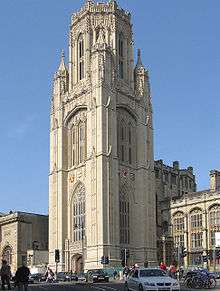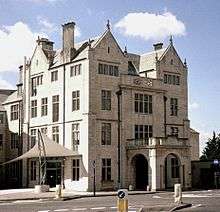George Oatley
| George Oatley | |
|---|---|
| Born |
1863 Bristol |
| Died | 1950 |
| Occupation | Architect |
| Practice | Oatley and Lawrence, Oatley and Brentnall |
Sir George Herbert Oatley (1863–1950) was an English architect noted for his work in Bristol, especially the gothic Wills Memorial Building, for which he was knighted in 1925.
Early life
Oatley was born in Bristol in 1863, and after working as an apprentice to the architect Thomas Dashwood, he became a junior draughtsman for the local firm Godwin and Crisp, at the age of 16. Oatley became Henry Crisp's partner aged only 26, when Godwin left the firm, and at the same time married Edith Lawrence.[1]
Work for Bristol University

His major break came with his appointment as Architect to the University of Bristol. One of his first projects, and probably the major one of his career, was to design the Wills Memorial Building to be a landmark for the new university, in 1912. He produced an imposing design in the Perpendicular Gothic style.[2] Building was begun in 1915, and after being delayed through World War I, it was finally completed in 1925. Oatley was knighted the same year in recognition of his work.[2]
His other work for the University included the H.H. Wills Physics Department, started in 1926 and opened in 1930; Wills Hall, a student hall of residence in Stoke Bishop in 1925; and Manor Hall, a student hall of residence in Clifton in (1932).[2][3]
Medical buildings

Oatley's works included the design of several mental hospitals throughout the country, including Winwick Asylum in Lancashire, the City of Cardiff Asylum at Whitchurch, Barrow Mental Hospital at Barrow Gurney, and extensions to the Beaufort War Hospital at Stapleton. He also designed the Bristol Homeopathic Hospital in 1908, (now the University of Bristol's Student Health Centre) and worked on improvements to the Bristol Royal Infirmary.[4]
Church buildings
Oatley's keen Christian faith is reflected in the large amount of work he did for local churches. He designed the mission hall of St Anne's in Greenbank (1900–01), Bristol Baptist College (1913–1915), St Edyth's in Sea Mills (1926–28). Other projects included work on St. Mary Redcliffe church and the New Room, John Wesley's original Methodist chapel.[5] Oatley was also involved in raising financial support for various Christian causes.[6]
Other work
Local Bristol firms also benefited from Oatley's designing talents, such as the J. S. Fry & Sons chocolate company, for whom he designed several factories, and the Bristol Wagon Works.
Oatley had worked on his own throughout his most prolific period, only joined by his brother-in-law George C. Lawrence in 1926. Ralph H. Brentnall joined the company in 1947, but it was only three years later that Oatley died in 1950. He had been based at 12 Great George Street, Bristol for the majority of his career.
References
- ↑ Burrough, THB (1970). Bristol. London: Studio Vista. ISBN 0-289-79804-3.
- 1 2 3 "BBC programme celebrates University architect". University of Bristol. Retrieved 19 November 2015.
- ↑ "Architect of Bristol". Green Hat. Retrieved 19 November 2015.
- ↑ "Celebrating city's shy architect". Bristol Post. 20 June 2011. Retrieved 19 November 2015.
- ↑ "Sir George Oatley Architectural Papers". Archives Hub. Retrieved 19 November 2015.
- ↑ "Sir George Oatley: Architect of Bristol". RIBA. Retrieved 19 November 2015.
Further reading
- Whittingham, Sarah (2009) "'The pride of Bristol, and an abiding monument to the genius of Sir George Herbert Oatley'", in: Ferry, Kathryn, ed. Powerhouses of Provincial Architecture, 1837-1914. London: Victorian Society; pp. 60–73
- Whittingham, Sarah M. (2005) Sir George Herbert Oatley (1863-1950); a Nonconformist architect: a critical biography and catalogue of works. 3 vols. Ph.D. thesis, University of Bristol.
External links
- Oatley Collection University of Bristol Library Special Collections